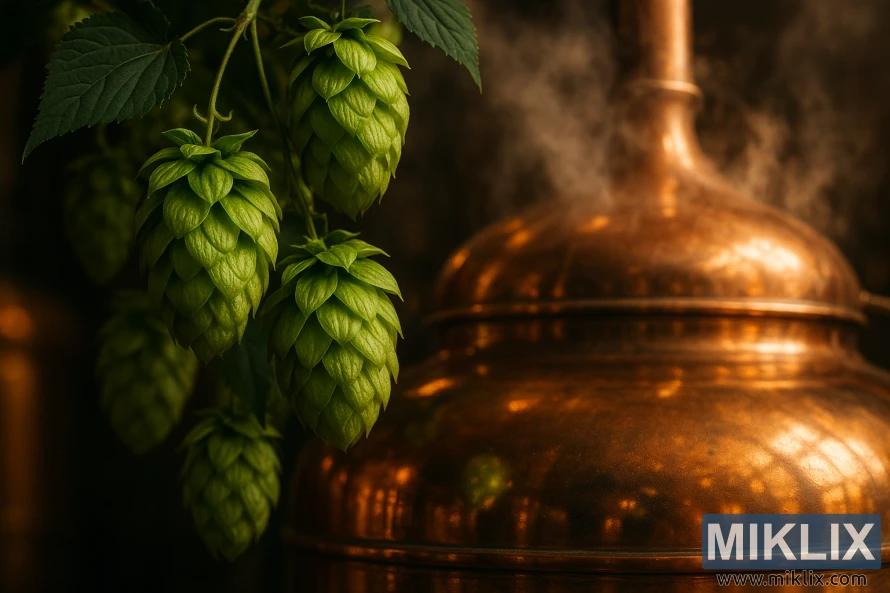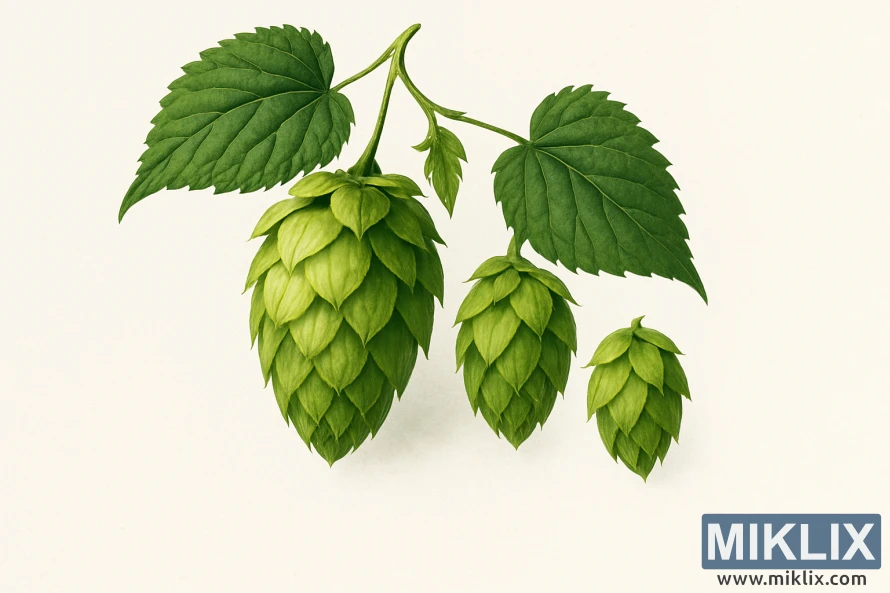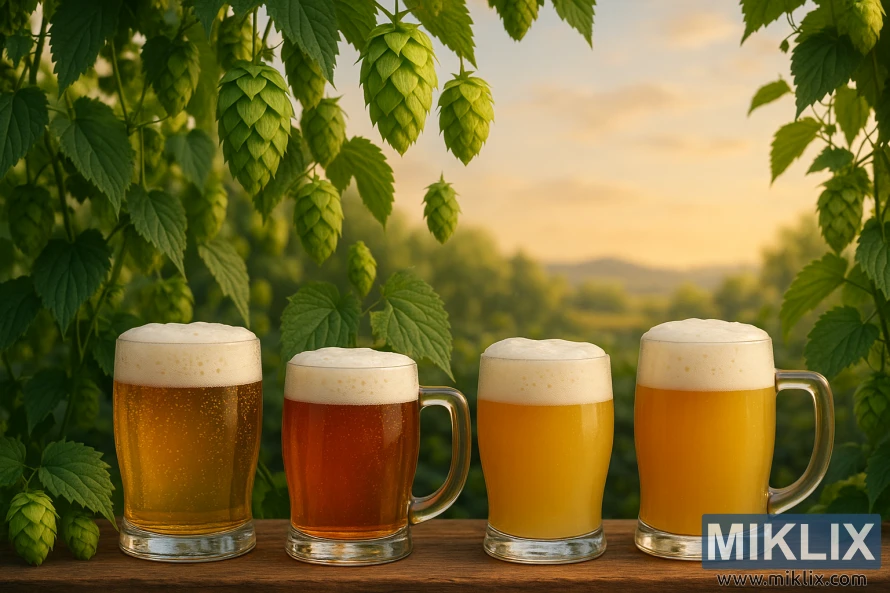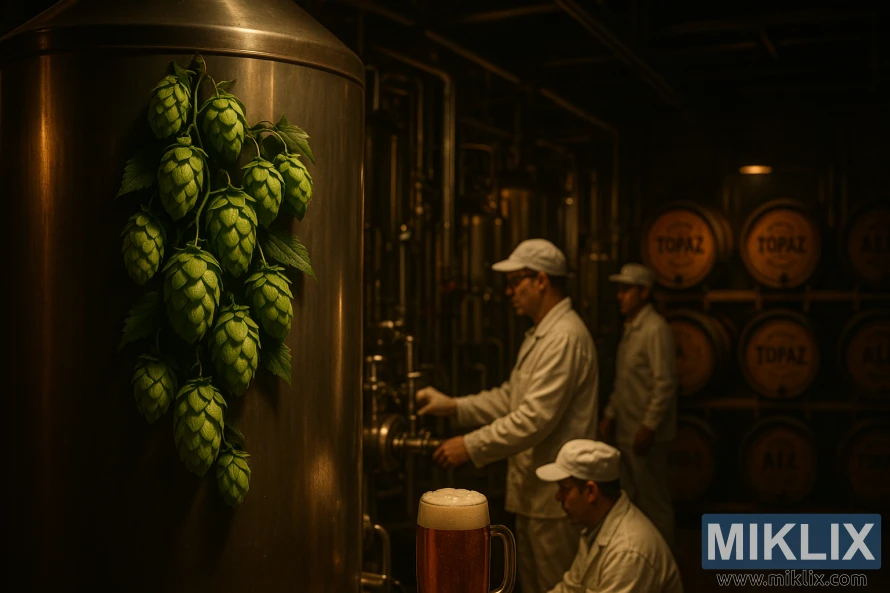Hops in Beer Brewing: Topaz
Published: August 6, 2025 at 5:00:04 PM UTC
Topaz Hops, a product of Australian breeding, were originally selected for their high alpha-acid content. This makes them ideal for extract production. They have also become a popular choice among brewers. This is due to their ability to create unique and flavorful beers. The versatility of Topaz Hops allows brewers to experiment with various beer styles. This includes IPAs to lagers. It enhances the aroma and bitterness of their brews. Understanding the characteristics and uses of Topaz Hops is essential for brewers aiming to produce high-quality beers.

Key Takeaways
- Topaz Hops are known for their high alpha-acid content.
- They are suitable for a variety of beer styles.
- Topaz Hops can enhance the aroma and bitterness of beer.
- Understanding Topaz Hops is essential for producing high-quality beers.
- They offer brewers the flexibility to experiment with different brews.
Introduction to Topaz Hops
The journey of Topaz Hops starts with their unique ancestry, rooted in Australian high alpha-acid varieties. They were created by crossing an existing Australian high alpha-acid variety with pollen from a Wye College male. This showcases the progress in hop breeding techniques.
Topaz Hops are the result of careful hop breeding programs. These programs aim to merge high alpha-acid content with unique flavor profiles. This effort has led to a hop variety that enhances both the bitterness and aroma of beers. It's not just versatile in brewing but also adds depth to the beer's character.
- High alpha-acid content, making them suitable for bittering
- A distinct flavor profile that adds complexity to beers
- A product of advanced hop breeding programs, showing the evolution of hop varieties
Topaz Hops have become a key ingredient in the brewing world. They are highly valued by craft brewers who aim to create unique and innovative beers.
The Unique Chemical Profile of Topaz Hops
Topaz Hops stand out due to their unique chemical makeup. They have a balanced mix of alpha and beta acids. These acids are key to their bittering and flavor.
The alpha acids in Topaz Hops add bitterness to beer. Beta acids, on the other hand, enhance flavor and aroma. This balance allows brewers to craft beers with complex, yet refined, flavors.
Topaz Hops also contain essential oils and other phytochemicals. These compounds add to their character. Essential oils are responsible for the hop's aroma, while other phytochemicals affect the beer's flavor and stability.
- Alpha acids contribute to bitterness
- Beta acids influence flavor and aroma
- Essential oils impact the hop's aroma
For brewers aiming to use Topaz Hops' unique traits, understanding their chemical profile is vital. By tapping into Topaz Hops' distinct qualities, brewers can create a variety of beer styles. This showcases the hop's versatility.
Characteristic Aroma and Flavor Notes
Topaz Hops are celebrated for their distinct aroma and flavor profiles. These elements are key in defining the character of various beers. They offer resinous and grassy flavors, alongside lychee and light tropical fruit aromas.
The blend of these hop characteristics makes Topaz Hops a valuable asset in brewing. They help in crafting complex and balanced beer flavors. This enhances the brewing experience.
- Resinous and grassy flavors add depth to the beer.
- Lychee and tropical fruit aromas provide a fruity and refreshing twist.
- The balance of these characteristics makes Topaz Hops suitable for a variety of beer styles.
By using Topaz Hops in their recipes, brewers can create beers with unique and appealing flavors. This sets their products apart in a competitive market.

Growing Regions and Cultivation
Topaz Hops are mainly grown in Australia's New South Wales and Victoria. These states have the perfect climate and soil for hop cultivation. The Australian hop farms here are known for producing top-notch hops.
The weather in New South Wales and Victoria is mild in winter and warm in summer. This is great for growing hops. The soil is also perfect, with good drainage and fertility.
Several factors are key to growing Topaz Hops successfully. These include:
- Climate: Mild winters and warm summers
- Soil: Well-drained and fertile ground
- Irrigation: Adequate water supply
- Farming practices: Crop rotation and pest management
Together, these elements in the Australian hop growing regions lead to high-quality Topaz Hops. These hops are in high demand by brewers around the world.
Alpha and Beta Acid Composition
Grasping the alpha and beta acid levels in Topaz Hops is key to perfecting beer's bitterness and flavor. Topaz Hops boast a balanced alpha and beta acid profile. This versatility makes them a go-to for brewers.
The alpha acid content in Topaz Hops spans from 13.7% to 20.1%. Beta acid content ranges from 4.9% to 7.9%. This wide range empowers brewers to fine-tune their hop additions for their beer recipes.
The alpha and beta acid balance in Topaz Hops enhances both bitterness and flavor. Alpha acids are the main contributors to beer's bitterness. Beta acids, on the other hand, influence flavor and aroma, more so during aging.
- Alpha acids: 13.7-20.1%
- Beta acids: 4.9-7.9%
- Provides a balanced bitterness and flavor
By comprehending Topaz Hops' alpha and beta acid composition, brewers can make strategic hop additions. This ensures their beers strike the perfect balance of bitterness and flavor. Such knowledge is vital for brewing exceptional beers that highlight Topaz Hops' unique traits.
Best Beer Styles for Topaz Hops
Topaz Hops stand out for their unique characteristics, making them perfect for several beer styles. These styles benefit from a robust flavor and aroma profile.
Topaz Hops are a great fit for IPA and pale ale styles. Their citrus and floral hints complement the hoppy and refreshing nature of these beers.
In brewing IPA, Topaz Hops balance bitterness and create a complex hop flavor profile. For pale ales, they introduce a subtle yet distinct character, elevating the drinking experience.
- IPA: Topaz Hops contribute to a robust hop flavor and aroma.
- Pale Ale: They add a subtle yet distinct character to the beer.
- Other styles: Topaz Hops can also be experimented with in other beer styles that require a similar hop profile.
Breweries have successfully used Topaz Hops in their IPA and pale ale recipes. This has resulted in beers that are both flavorful and aromatic. By understanding Topaz Hops' best applications, brewers can craft high-quality beers that highlight this hop variety's unique qualities.

Storage and Handling Requirements
To preserve Topaz Hops' unique characteristics, brewers must follow specific storage and handling practices. These hops, like others, are sensitive to temperature, moisture, and light. Such factors can impact their flavor and aroma.
Proper storage is essential for maintaining Topaz Hops' quality. Here are some key considerations:
- Store Topaz Hops in a cool, dry place, away from direct sunlight.
- Maintain a consistent refrigerated temperature between 32°F and 40°F (0°C and 4°C) to slow down the degradation process.
- Use airtight containers or packaging that prevents exposure to air and moisture.
Correct handling of Topaz Hops is also vital. Brewers should:
- Minimize the time hops are exposed to air during the brewing process.
- Keep hop pellets or whole cones sealed until use.
- Avoid handling hops excessively, as this can cause breakage and loss of essential oils.
By adhering to these storage and handling guidelines, brewers can ensure Topaz Hops retain their characteristic flavor and aroma. This enhances the quality of their beers. Effective hop management is a critical step in brewing, contributing to the consistency and excellence of the final product.
Brewing Techniques with Topaz Hops
To maximize Topaz Hops, brewers use various methods like dry hopping and late additions. These approaches help to showcase Topaz Hops' unique traits, enriching the taste and scent of beers.
Topaz Hops stand out for their distinct aroma and flavor, making them a favorite among brewers. Dry hopping and late additions are key techniques for extracting Topaz Hops' best qualities.
Dry hopping involves adding hops post-fermentation, usually during conditioning. This method allows the hops to add their aroma without bitterness. For Topaz Hops, dry hopping enhances floral and citrus notes, leading to a more aromatic beer.
Late additions, on the other hand, involve hops added towards the end of the boil. This can be in the last 10-15 minutes or even later, during the whirlpool or knockout. Late additions with Topaz Hops boost the beer's flavor and aroma, as they contribute less bitterness.
Some brewers mix brewing techniques. For example, using Topaz Hops for both bittering and dry hopping can create a balanced beer with a strong hop presence. Yet, it's essential to balance hop additions to prevent overpowering other flavors.
- Experiment with different hop addition times to find the optimal balance for your beer.
- Consider the overall hop profile you want to achieve and adjust your brewing techniques according.
- Remember, the quality and storage conditions of your hops greatly affect your beer's final flavor and aroma.
Commercial Brewing Applications
Topaz Hops stand out as a top choice for large-scale brewing. Commercial breweries seek hop varieties that bring unique flavors to their beers. Topaz Hops meet this need perfectly.
In commercial brewing, Topaz Hops are prized for their complex flavor and aroma. They offer citrus, pine, and earthy notes. This makes them ideal for a wide range of beer styles, from pale ales to IPAs.
When brewing on a large scale, the alpha and beta acid content of Topaz Hops is key. They have a moderate alpha acid level. This makes them versatile for both bittering and adding flavor and aroma.
- Topaz Hops can be used for bittering due to their moderate alpha acid content.
- They are also effective for flavor and aroma additions, enriching the beer's character.
- Their unique profile makes them a favorite among craft breweries seeking innovation.
By using Topaz Hops, commercial breweries can craft unique, high-quality beers. The secret is to balance Topaz Hops with other ingredients. This ensures the desired flavor and aroma.

Substitutions and Complementary Hop Varieties
Topaz Hops offer brewers a range of options for substitutions and complementary varieties. This versatility allows for the creation of unique and flavorful beers through different hop combinations.
Topaz Hops can be replaced with Galaxy and Citra hops, which share similar traits. Galaxy Hops, for instance, bring a tropical fruit flavor and aroma. This complements Topaz's citrus and pine notes, creating a harmonious blend.
- Mosaic Hops for added complexity and fruitiness
- Simcoe Hops for a piney and earthy flavor profile
- Amarillo Hops for a citrusy and floral character
These pairings can enhance the beer's flavor and aroma, creating a complex profile. The goal is to experiment with ratios and combinations to achieve the perfect balance for your beer style.
Some beer styles that benefit from these hop substitutions and combinations include:
- India Pale Ales (IPAs)
- Pale Ales
- Double IPAs
Understanding Topaz Hops and their substitutions and complementary varieties opens up new possibilities in beer brewing. Brewers can explore and create unique flavors by experimenting with different hop combinations.
Common Brewing Challenges and Solutions
Topaz Hops bring a unique flavor to beers, but brewers often face issues that impact quality. One major concern is ensuring consistency in flavor and aroma.
Several factors can affect Topaz Hops' performance in brewing. These include storage conditions, handling practices, and brewing techniques. It's essential to understand these factors to troubleshoot common problems.
- Inconsistencies in flavor and aroma
- Difficulty in achieving the desired bitterness level
- Issues with hop storage and handling that affect quality
To overcome these challenges, brewers can take several steps. For example, storing Topaz Hops in a cool, dry environment helps preserve their flavor and aroma.
For consistent flavor and aroma, brewers should follow these best practices:
- Use a consistent hopping schedule and rates.
- Monitor and adjust brewing water chemistry as needed.
- Optimize brewing techniques, such as hop addition timing and temperature control.
Troubleshooting brewing issues with Topaz Hops also involves understanding their alpha and beta acid composition. Adjusting brewing techniques based on the specific characteristics of the hops can help achieve the desired beer profile.
By being aware of the challenges with Topaz Hops and implementing effective solutions, brewers can create high-quality beers. These beers will showcase the unique attributes of these hops.
Recipe Development Guidelines
Recipe development with Topaz Hops can lead to exceptional beers, from IPAs to pale ales. Topaz Hops stand out due to their unique chemical profile. This makes them an excellent choice for various beer styles.
When developing recipes with Topaz Hops, brewers should focus on the alpha and beta acid composition. They should also consider the characteristic aroma and flavor notes. Topaz Hops have a moderate alpha acid content. This makes them suitable for both bittering and flavor/aroma additions.
Here are some guidelines for incorporating Topaz Hops into your beer recipes:
- Use Topaz Hops as a bittering hop for a clean, crisp bitterness.
- Add Topaz Hops during the flavor/aroma hop addition for a complex blend of citrus and floral notes.
- Experiment with different proportions of Topaz Hops to other hop varieties to create unique flavor profiles.
Some successful beer recipes that feature Topaz Hops include:
- IPA recipes that combine Topaz Hops with other citrus-forward hop varieties.
- Pale ale recipes that use Topaz Hops for both bittering and flavor/aroma additions.
- Sour beer recipes that incorporate Topaz Hops for added complexity.
By following these guidelines and experimenting with different recipes, brewers can unlock the full flavor of Topaz Hops. This allows them to create a wide range of delicious beers.

Quality Assessment and Selection
Evaluating the quality of Topaz Hops is essential in brewing. Brewers must scrutinize the hops to guarantee the best flavor and aroma. This step is critical for achieving the desired taste in beer.
Quality assessment entails examining the hops' appearance, aroma, and moisture levels. Premium Topaz Hops should display a vibrant green hue and emit a fresh, floral scent.
When choosing Topaz Hops, brewers should focus on the alpha and beta acid content. The alpha acid content should fall between 14% and 17%. This ensures the hops contribute the right bitterness to the beer.
- Inspect for any signs of deterioration or contamination.
- Confirm the aroma aligns with the expected profile.
- Verify the moisture content is within the recommended range.
By meticulously assessing and selecting Topaz Hops, brewers can guarantee their beer meets the desired flavor and aroma standards.
Impact on Final Beer Characteristics
Topaz Hops bring a unique set of flavors and aromas to beer, elevating its quality. Their distinct chemical profile makes them perfect for brewers aiming to craft complex, distinctive beers.
Adding Topaz Hops to the brewing process significantly shapes the beer's final characteristics. They introduce citrus, pine, and earthy notes, adding depth and complexity. The aroma can range from floral to spicy, enriching the beer's sensory experience.
In various beer styles, Topaz Hops impart unique traits. In pale ales, they highlight citrus flavors. In porters, they add a subtle earthy undertone. Their versatility makes them ideal for a broad range of brewing applications.
The advantages of using Topaz Hops include:
- Enhanced flavor complexity
- Unique aroma profiles
- Versatility across different beer styles
Understanding Topaz Hops' impact on beer characteristics helps brewers make informed decisions. They can create traditional styles with a twist or entirely new profiles. Topaz Hops are a valuable tool for brewing innovation.
Conclusion
Topaz Hops bring a unique twist to various beer styles, thanks to their distinct chemical profile. They offer a blend of aroma and flavor that can elevate any brew. By grasping the nuances of their growing regions, acid composition, and storage needs, brewers can craft exceptional beers.
Experimenting with Topaz Hops in different brewing techniques and styles is key to mastering them. Brewers can mix and match these hops with others to fine-tune their beer's flavor. Following recipe guidelines and evaluating hop quality ensures the best use of Topaz Hops.
Understanding how Topaz Hops affect a beer's flavor, aroma, and bitterness is essential. This knowledge allows brewers to create complex, unique beers that showcase Topaz Hops' benefits. With these insights, brewers can confidently add Topaz Hops to their repertoire, expanding their creative horizons and producing outstanding beers.
Further Reading
If you enjoyed this post, you may also like these suggestions:
